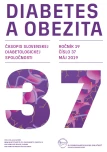New technologies in diabetology of continuous monitoring – new options in the treatment of diabetes mellitus
Authors:
Viera Doničová
Authors‘ workplace:
Poliklinika Juh – Neštátna diabetologická, interná a metabolická ambulancia, Košice
Published in:
Diab Obez 2019; 19(37): 27-31
Category:
Reviews
Overview
Continuous glucose monitoring has been one of the most important achievements in diagnosing and treating diabetes over the past 20 years. While in the past the doctor would implement a treatment for a diabetic patient based on a single blood glucose value measured at the outpatient clinic and urine glucose testing, today we are able to obtain the value of glucose over time, thanks to the technology, in the form of o curve. On this curve we can monitor the effect of a specific food, physical movement, administered insulin, stress, and other factors that change blood glucose levels. It is of great benefit that we can see nocturnal hypoglycemia in sleep on the curve, unrecognized until now, which even the patient is sometimes not aware of.
Received 20. 4. 2019
Accepted 1. 5. 2019
Keywords:
insulin – hyperglycemia – artificial pancreas – continuous glucose monitoring – continuous subcutaneous insulin infusion – flash glucose monitoring – hypoglycemia – multiple daily injections – sensoraugmented pump – time in range TIR – type 1 diabetes – type 2 diabetes
Sources
-
Battelino T, Conget I. Olsne B et al. J SWITCH Study Group. The use and efficacy of continuous glucose monitroing in type 1 diabetes treated with insulin pump therapy a randomised controlled trial. Dibaetlogia 2012; 55(12): 3155–3162. Dostupné z DOI: <http://dx.doi.org/10.1007/s00125–012–2708–9>.
-
Lind M, Polonsky W, Hirsh IB et al. Continuous glucose monitoring vs Conventional Therapy for Glycemic Control in Adults with type 1 Diabetes Treated With Multiple Daily Insulin Injection: Thé GOLD Randomiyed Clinical Tiral. Jama 2017; 317(4): 379–387. Dostupné z DOI: <http://dx.doi.org/10.1001/jama.2016.19976>. Erratum in Incorrect Unit of Measure. [JAMA. 2017].
-
Beck RW, Riddelsworth T Ruedy K et al. [DIAMOND study group]. Effect of Continuous Glucose monitoring on Glycemic Control in Adults With Type 1 Diabetes Using Insulin Injections: Rhe DIAMOND Randomized Clinical Trial. JAMA 2017; 317(4): 371–378. Dostupné z DOI: <http://dx.doi.org/10.1001/jama.2016.19975>.
-
Garg SK, Weinzimer SA, Tamborlane WV et al. Glucose Outcomes with the in-home Use of a Hybrid Closed-Loop Insulin Delivery System in Adolescents nad Adults with Type1 Diabetes. Diabetes Technol Ther 2017; 19(3): 155–163. Dostupné z DOI: <http://dx.doi.org/10.1089/dia.2016.0421>.
-
[Juvenile Diabetes Research Foundation Continuous Glucose Monitoring Study Group]. Effeciveness of continuous glucose monitoring in a clinical care environment evidence Rom thé Juvenile Diabetes Research Foundation continuous glucose monitoring (JDRF-CGM) trial. Diabetes Care 2010; 33(1): 17–22. Dostupné z DOI: <http://dx.doi.org/10.2337/dc09–1502
-
Bergenstal RM, Tamborlane WV Ahmann A et al. [Star 3 Study Group]. Effectiveness of sensor-augmented insulin-pump therapy in type 1 diabetes. N Engl J Med 2010; 22 ;363(4): 311–320. Dostupné z DOI: <http://dx.doi.org/10.1056/NEJMoa1002853>. Erratum in N Engl J Med 2010; 363(11): 1092.
-
El Laboudi AH, Godsland IF, Johnson DG et al. Measures of Glycemic Variability in Type 1 Diabetes nad the Effect of Real Time Continousu Glucose Monitoring. Diabetes Technol Ther 2016; 18(12): 806–812. Dostupné z DOI: <http://dx.doi.org/10.1089/dia.2016.0146>.
-
Garg SK, Schwartz S, Edelman SV. Improved glucose excursions using an implantable real-time continuous glucose sensorin adults with typ 1 diabetes. Diabetes Care 2004; 27(3): 734–738.
-
Nalysnyk L. Hermandey-Medina M et al. Glycaemic variability nad complications in patients with diabetes mellitus:evidence Rom a systematic review of the literature. Diabets Obes Metab 2010; 12(4): 288–298. Dostupné z DOI: <http://dx.doi.org/10.1111/j.1463–1326.2009.01160.x>.
-
Bragd J, Adamson U, Backlund LB et al. Can glycaemic variability as calculated Rom bood glucose self-monitoring predict thé development of complications in type 1 diabetes over a decade? Diabetes Metab 2008; 34(6 Pt 1): 612–616. Dostupné z DOI: <http://dx.doi.org/10.1016/j.diabet.2008.04.005>.
-
Šoupal J, Škrha J jr, Fajmon M et al. Glycemic vairability is higher in type1 diabetes patients with microvascular complications irrespective of glzcemic control. Diabetes Technol Ther 2014; 16(4): 198–203. Dostupné z DOI: <http://dx.doi.org/10.1089/dia.2013.0205>.
-
Bolinder J, Antuna R, Geelhoed-Duijvestijn P et al. Novel glucose - sensing technology nad hypoglycaemia in type 1 diabetess a multicentre, non - masked, randomised controlled trial. Lancet 2016; 388(10057): 2254–2263. Dostupné z DOI: <http://dx.doi.org/10.1016/S0140–6736(16)31535–5>.
-
Rodbard D. Continuous Glucose Monitoring: A Review of Recent Studies Demonstrating improved Glycemic Outcomes. Diabetes Technol Ther 2017; 19(S3): S25-S37. Dostupné z DOI: <http://dx.doi.org/10.1089/dia.2017.0035>.
-
Kovatchev BP, Patek SD, Ortiz EA et al. Assessing sensor accuracy for nonadjunctuse of continuous glucose monitoring. Diabetes Technol Ther 2015; 17(3): 177–186. Dostupné z DOI: <http://dx.doi.org/10.1089/dia.2014.0272>.
Labels
Diabetology ObesitologyArticle was published in
Diabetes and obesity

2019 Issue 37
Most read in this issue
- 50 rokov Slovenskej diabetologickej spoločnosti
- Hypoglycaemia in diabetes mellitus
- Odišiel MUDr. Peter Pavlov, MPH (*8. 6. 1962 – †19. 4. 2019)
- Metformin in patients with chronic kidney disease and cardiovascular disease
